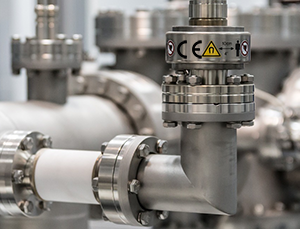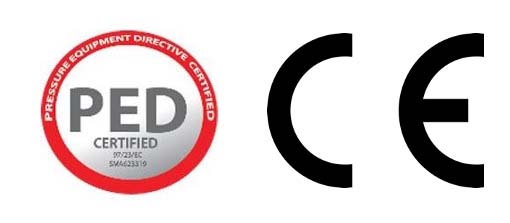Pressure Equipment Directive, Sound Engineering Practice, and CE Markings

Figure 1: CE marking on pressure pipe.
The pressure equipment directive, sound engineering practice, and CE markings are all part of the European Union's Pressure Equipment Directive 97/23/EC (PED). Following several directives that dealt with pressure instruments, the European Union instated the PED 97/23/EC to set a common standard in design, production, testing, marking, and labelling of the pressurised equipment for manufacturers and operators.
PED is both aimed at ensuring all pressure equipment, and related equipment, is safe for use across the European Economic Area. The equipment subjected to the directive may include pressure vessels, pipes, safety components, and pressure accessories such as flange and nozzles.
The Conformitè Europëenne (CE) mark indicates the product’s compliance with the requirements of the derivative. PED and CE marking makes it easier to ensure common conformance and ease of trade across the EU.
Pressure equipment directive importance
Depending upon the type of fluid or gas, maximum allowable pressure, volume, and hazard level of the fluid or gas, pressure measuring components were subjected to different requirements, different in each country of the EU. This caused a wide range of trade difficulties with manufacturers having to seek multiple approvals to ensure local manufacturing and safety standards.
The Pressure Equipment Directive provides a common legal framework for pressure equipment manufacturers across the EU. The directive sets the common standard in the design, production, testing, marking, and labeling of the pressurized equipment and consists of:
- SEP: Sound engineering practice
- Category 1
- Category 2
- Category 3
- Category 4
The least hazardous is SEP, and the most hazardous is Category 4. With increasing hazards, quality assurance during design, manufacture, and testing will become more extensive. Following the quality assurance process, categories 1 to 4 will be marked with the CE mark. SEP products do not require the CE mark, it is also expressly forbidden to mark SEP-products with the CE mark.
The key requirements in PED include:
- PED is required for pressure equipment rated for more than 0.5 bar (7.25 psi).
- For pressure equipment that do not fall under the CE categories 1 through 4, Sound Engineering Practice (SEP) must be used during design and production. The SEP refers to the general engineering practices followed by the member states that apply to the pressure equipment that ensures sound use and conformity to the design and manufacturing standards.
- For pressure equipment that does reach the criteria for CE categories, the basic safety requirement of the PED should be met. This may require a pressure test as proof of pressure strength. An EU/EC declaration of conformity must be prepared once the pressure test is performed and the instrument will be marked CE once all the requirements are met.
- It is not allowed to mark-up equipment. A category 2 product may not be assigned a category 3, or 4. The intention of the directive is to show the true pressure category.
Our introduction to the pressure equipment directive sets out the requirements and steps to be taken to assess whether or not a product should go through a quality assurance program for a CE marking, or whether the product is covered under SEP. PED is not intended for use in the United States. In the US, the ASME BPVC (American Society of Mechanical Engineers Boiler and Pressure Vessel Code) regulates the construction and design of pressure equipment.

Figure 2: CE marking and PED certification
Pressure equipment covered by the PED
The directive covers the following pressure equipment and accessories:
- Vessel: An enclosure for containing pressurized fluids. The vessel includes all direct attachments to other equipment until the coupling. There may be multiple chambers in a vessel.
- Steam generator: Steam generators are heated pressure equipment designed to produce steam or superheated water at temperatures higher than 110C.
- Piping: Component used to transport liquids. Piping includes a pipe or a system of pipes, tubing, expansion joints, fittings, hosing, or other pressure-bearing components. The term includes heat exchangers containing pipes for the cooling or heating of air.
- Safety accessories: Safety accessories protect pressure equipment from exceeding its allowable limits; safety valves, bursting discs, pressure switches, and temperature switches are all included.
- Pressure accessories: Devices with a pressure-bearing housing and an operational function, such as valves, pressure regulators, pressure gauges, and filters, are considered pressure accessories.
- Assemblies: Assemblies are defined as pressure equipment produced by one manufacturer to form a functional and integrated unit, such as distillation units, evaporation units, and filtration units.
In some cases, PED does not cover pressure equipment even though they are designed within the limits. The conditions include:
- Equipment already regulated by the EU.
- Equipment with minor pressure hazards: low voltage machinery and devices.
- Equipment that does not exhibit any pressure hazard: water distribution system, radiators, pipe networks for hot water heating system.
- Equipment with considerable pressure hazard, but does not require inclusion in the directive: high voltage devices such as switchgear.
CE marking
Conformitè Europëenne (CE) markings in equipment indicate the product’s compliance with the directive according to the EU/EEA regulation which means they meet all the required safety, health, and environmental protection regulations for the EU.
The CE marking is required only for those products for which the EU specifications exist and must not be used for products that do not require it, such as SED-type products. The directive for each category specifies whether a third-party assessment is required or not for obtaining a CE marking. The equipment itself does not require any license to get the CE marking but must conform to the following rules:
- Compliance with the PED and all related EU regulations.
- Conformity assessment and documentation.
PED in the United Kingdom post Brexit
Once the United Kingdom left the European Union in 2020, the PED entered a transitional phase in the United Kingdom that will see the introduction of the UK Conformity Assessed marking (UKCA). The CE mark will no longer be accepted on goods put on the market in Great Britain (England, Wales, Northern Ireland, and Scotland) after the 31st of December 2021.
UK companies that plan on placing pressure equipment in the European market will still need to put the CE mark on their products. However, these products must be approved by a body established in the European Union.

Figure 3: UKCA mark




